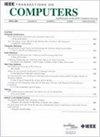High-Precision Error Bit Prediction for 3D QLC NAND Flash Memory: Observations, Analysis, and Modeling
IF 3.6
2区 计算机科学
Q2 COMPUTER SCIENCE, HARDWARE & ARCHITECTURE
引用次数: 0
Abstract
In the age of artificial intelligence, large language models (LLM) require rapid development along with massive volumes of training data and parameter storage. Over the past decade, 3D NAND flash memory has emerged as the dominant non-volatile memory technology due to its high bit density and large capacity. However, because of its 3D vertical stacking technique and array designs, 3D NAND flash memory has more complicated data loss mechanisms compared to 2D NAND flash memory. As bit densities rise to Quad-level-cells (QLC), the small read margins will further complicate and make the situation more unpredictable. In this work, we propose an error-bit prediction model in this paper for 3D QLC NAND flash memory with the charge-trap (CT) cell structure based on a thorough analysis of multiple parameters that affect the error-bit distributions, including read disturb (RD) and degradation from program/erase (PE) cycles. Specifically, we develop the whole-block prediction (WBP) and the dynamic-worst-page prediction (DWPM) models. It is shown that the proposed models can be used for high-precision error-bit prediction to guarantee data reliability in commonly used NAND-based storage systems based on the characterization results of raw NAND chips.求助全文
约1分钟内获得全文
求助全文
来源期刊

IEEE Transactions on Computers
工程技术-工程:电子与电气
CiteScore
6.60
自引率
5.40%
发文量
199
审稿时长
6.0 months
期刊介绍:
The IEEE Transactions on Computers is a monthly publication with a wide distribution to researchers, developers, technical managers, and educators in the computer field. It publishes papers on research in areas of current interest to the readers. These areas include, but are not limited to, the following: a) computer organizations and architectures; b) operating systems, software systems, and communication protocols; c) real-time systems and embedded systems; d) digital devices, computer components, and interconnection networks; e) specification, design, prototyping, and testing methods and tools; f) performance, fault tolerance, reliability, security, and testability; g) case studies and experimental and theoretical evaluations; and h) new and important applications and trends.
 求助内容:
求助内容: 应助结果提醒方式:
应助结果提醒方式:


